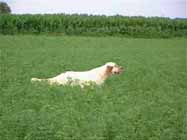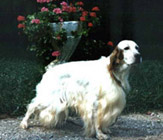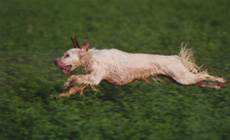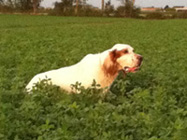The
gait is brisk gallop, elegant and fast but not impetuous, so comparing
it with the pointer one is a little less speed. For a given length of
the body, it takes place on a line more near land (grazing), and oversees
more, also, the slight undulations of the ground, so that is more "sweet".
And this is in relation to the expected structure of the standard corresponding
to the mind that makes it appropriate to a different movement of the limbs.
The humerus of the pointer, for shorter than the radius, angle decreases
the chances of support and perhaps the distance of the front legs. Then,
the back (rear region) is built
for bucking the powerful and the two hindlegs give the driving force in
two stages, yes, but tighter, more and stretch back. In the English setter,
instead, times are wider, and the hindlimbs longer work separately. Overall
the impression is of a system of transportation is not less perfect than
the pointer one, however different, more flexible if less audacious, able
to greater resistance. The cross looks
instinctively shorter diagonal, a little less distance, and this due to
the tendency to inspect deeper into the ground. Education, however, may
also reach the lenght of best pointers. These diagonals, then, are not
rigidly straight, but often the path followed by the dog is slightly meandering
than the straight line joining the two extreme points of the diagonal
itself (and this as a result of this particular diligence in the inspection
of the ground).
Easy
to sudden changes in direction, then resumed in the regular way. The tail
is carried according to the extension of the topline, with a tendency
to low (never higher) very much alive and nervous, in a straight line
at high speed moves only from top to bottom. But since, as has been said,
it is mainly concerned of going and tends to more analysis, very easy
for the detachment of the straights (where the tail fringed is used as
helm), and the continuing very slight slowdown with immediate recovery
(which dictated, first of its kind which is found in those clear lenses,
which beat its tail happily looking), for all these reasons, the concomitant
large "trialers" oscillations can be seen up and down often
combined with transversal motions, which content resulting in rotations,
with the rhythmic canter, now right, now left, depending on the time of
rotation of the gallop. Posture of the head and nose high, but not so
hard as in the constant Pointer: the head is more mobile, denoting vigilance
in the olfactory goal, while the one that seems almost automatically.
The ears, light and live, vibrate between nape and neck without too much
chattering above and below the skull during gallop.
Entering an area slightly impregnated with scent, this Trialer drops throughout
the body, and sometimes the nose emerges from the tall grasses. And comeback
in the wind, following the issue as directly as possible, cautious and
suspicious, jog or brisk, with marked muscle contraction and movement
of the blades.
Its advance is extremely quiet, and the motion of the limbs so harmonious,
that often, if the vegetation is a little high, gives the impression of
magical power to move, pulled by an invisible thread, having turned legs
into sliding wheels.
If it is persuaded that the wild is already blended, gradually rises and
increasing the pace, he resumed his usual race.
On the other hand, if it is unaware of the presence of the wild, gradually
slows and stiffens into "strong" attitudes often mask a sneer,
his eyes shining, tail outstretched and motionless, following the line
of the kidney, ever higher, sometimes slightly curved.
It is preferred in this case, the pointing stand: the head erect, with
the muzzle horizontal or upright, ears folded back, only erected from
time to time. Of wild hare or very near, usually the ears are erect. If,
during search in full scent area that gives it immediately certain about
presence of the wild, with a sudden contraction it shrinks and stops posing
feline. Then, began the "spun" as described above, almost crawling
the sternum grazing land, with exceptional bending all joints of the limbs
that allow him, even in that posture, a step very long compared to the
cat one, for example, incompatible, with the structure of the pointer.
The game is highly visible from the tips of the blades protruding withers.
Then gradually gets up and goes into a little steady as already described
in more or less to the ground. Whether galloping suddenly enters into
scent directed, even if grass is little, it disappears on the ground,
as if swallowed up by magic; approaching, it is in incredibly contracted
pose, spasmodic, very strict.
The difference in attitudes between the action precdes the steady of pointer
and setter do so that, even if the same nose, the pointer still longer,
because it knows that its action does not allow him to bully come too
close to the wild, while the setter knows that its insidious and hidden
action allows him to push the boundaries.
When the wild, on the arrival of trainer, try to get away, the English
setter, taking care to follow him ever losing contact, as a Panther, displaying
a wide variety of poses .
Note that the action of "crawled" is always so low, creeping
as the setter has fear of being seen by game (open ground). When, by contrast,
it is seen as a good wind, very favorable, and vegetation sufficiently
developed, then all the work is higher, at a distance, less suspicious,
and are still standing, with legs flexed soon.

















